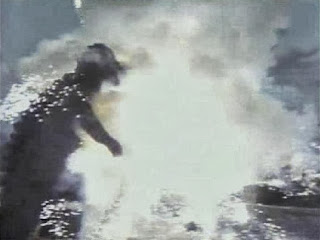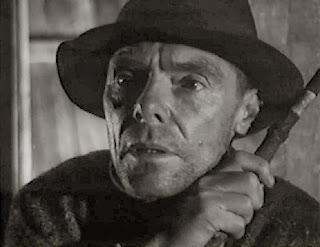... aka: Alice or the Last Escapade
Directed by:
Claude Chabrol
Prolific French director Chabrol's
loose adult interpretation of Lewis Carroll's children's classic Alice
in Wonderland went unnoticed in its day and continues to go unnoticed
to this day despite the pedigree of its acclaimed director (who was
often compared to Hitchcock by critics) and the notoriety of star
Sylvia Kristel; who was fresh off her international success in Just
Jaeckin's lush soft-core hit Emmanuelle (1974) when she took on
this role. And its obscurity is pretty easy to understand once you
actually sit down and watch the dreary finished product. Alice Carroll
decides to get "far, far away" from her inattentive, self-absorbed husband
Bernard (Bernard Rousselet) after just five years of marriage. On a
dark and stormy night, Alice takes off in her car. While driving down a
stretch of vacant country road, her windshield mysteriously shatters and
she's forced to pull over. Noticing a gate, she makes her way to a
secluded mansion. She's invited inside by the hospitable Henri Vergennes (Charles
Vanel), who lets her warm herself by a fire, feeds her and then offers
her a play to stay for the night. Despite initial reluctance, Alice
agrees. Servant Colas (Jean Carmet) shows her to her bedroom.
Inside is a clock that's stopped. Colas notes "We don't care too much
about time here."
When Alice awakens from her sleep, she notices some strange, subtle
changes about her surroundings. She appears to be in a different place and
the mansion is vacant, but someone's left coffee and breakfast for her.
When she goes outside, she notices the windshield on her car has also been
repaired. Attempting to leave, Alice finds the only road out is blocked,
so she decides to walk and realizes that a very tall stone wall surrounds
the entire property and there's no gate. A man dressed in white appears
out of the woods and tells her not to ask him any questions and not to
touch him before he disappears. Now trapped inside and with no other real
option, Alice is forced to go back to the house, where a sinister-sounding
disembodied voice warns her not to leave. A fireplace starts by itself,
fixings are left for her dinner and other odd people show up. A man
dressed in black appears and tells her "Questions are useless... when
there are no answers" and keeps talking about other people who'd come
there prior to Alice and how they weren't quite so well behaved. A little
boy notes that birds are stupid because they can't even figure
out how to leave a cage when the door is left wide open.
All of the highly secretive and bizarre people Alice meets speak in riddle
and hide their names and true identities. They all seem to know her
name, though, despite the fact she hasn't told them. Wind blows her across
the room, a snail appears on her windshield, dead birds are found all over
the roads, images ripple and are distorted, and she finally manages to escape the grounds, only to find the people she
meets outside the gate at a gas station and a cafe are just as strange as
the ones she met at the mansion. Has Alice stumbled upon a haunted house?
Has she somehow entered into another dimension? Is she dead and this is
what the afterlife is like? Has she gone mad? The secret lies behind a
locked door in the mansion...
A very slow-paced and somber film, this defies easy categorization and has
elements of drama, mystery, fantasy and horror all at play. It's
technically well-made, nicely photographed by Jean Rabier and Chabrol manages to ratchet
up a high amount of intrigue and suspense during the first half, but sadly
it's not well sustained for the duration and the events grow tiresome and
repetitive. In fact, the end revelation; which is so predictable that
revealing it won't even really spoil anything, has been swiped directly
out of the creepy cult classic Carnival of Souls (1962). There are
many long, dull, dialogue-free sequences of our heroine simply walking
around the grounds and inside the home. Allusions to the Alice
story are numerous, but don't expect anything in the way of special
effects, strange animals and creatures, elaborate fantasy art direction or
the like. This is set almost entirely inside a dark, gloomy mansion and
its surrounding property, and many reflections of the story are done
strictly via costume color and the concentration on doorways and food and
drink consumption.
As far as Kristel is concerned, she's nice to look at - and has a
customary nude scene - but doesn't do anything here to really change my
opinion of her being more of a model than an actress. Her "Alice" is
supposed to be strong-willed and tough, but Kristel usually just comes
across as vacant. Her exposure in the aforementioned Emmanuelle not
only led to starring roles in other Euro sex films (including numerous
Emmanuelle sequels) but also artier ones like this and others for
the likes of Alain Robbe-Grillett, Roger Vadim and Fons Rademakers. An
attempt at American crossover success failed after several high profile
flops like the all-star disaster movie The Concorde: Airport '79
(1979) and the Maxwell Smart comedy The Nude Bomb (1980). She went
back to soft-core and scored a few more hits in the 80s like Lady
Chatterley's Lover (1981) and Private Lessons (1981). As she
reached middle age in the 90s, her decreasing sex appeal and the fact her
acting didn't improve much, saw her fading from the public eye and she
quietly passed away with little press attention in 2012.
★★1/2































































